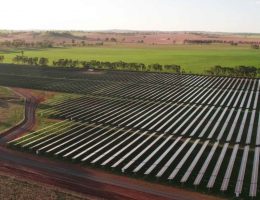Federal energy and emissions reduction minister Angus Taylor now believes Australia can meet its 2030 emissions reduction target without the need of surplus Kyoto units, despite Australia spending the last two weeks derailing international climate talks by pushing for their inclusion.
Taylor told the Australian Financial Review that he has a growing expectation that Australia could achieve its 2030 emissions reduction target without needing to rely on the use of “overachievement” from the 2020 target.
It confirms earlier reports from other sources that Taylor and Australian diplomats had started using this line in Madrid. As one attendee told RenewEconomy: “They were running that line in meetings which made their obstinacy more amazing and annoying to other countries.”
Taylor told the AFR that Australia is “already on track” to beat its 2030 targets.
“Our track record for finding additional abatement year-on-year has been extraordinary. There is a broad recognition that Australia has over-delivered. There are few countries with our track records.”
“That’s our approach, which is to over-deliver, and we will look to over-deliver to 2030 as well,” Taylor added.
Is this true? Taylor has said repeatedly that he has a plan to emission reductions “to the very last tonne”, despite his department being less confident of the fine details.
But as they currently stand, projections of Australia’s greenhouse gas emissions, prepared by the Department of the Environment and Energy, show Australia’s emissions out to 2030 declining by just 16 per cent compared to 2005 levels, and well short of the 26 to 28 per cent target set by the government.
Not once has the Department of Environment and Energy’s projections of Australia’s greenhouse gas emissions shown that Australia is on track to meet its 2030 emissions reduction target.
The latest projections still clearly show the Morrison government is expecting to rely upon the use of “overachievement” in Kyoto, which were largely generated as a result of overly soft targets under the Kyoto Protocol, to reach the 2030 target.

To say that Australia could now be on track to meet the 2030 target without using credit from “overachievement” is a bizarre claim, as it means Taylor is effectively banking on the recently updated greenhouse gas emissions projections prepared by his department being wrong.
It doesn’t demonstrate much confidence on the government’s ability to predict Australia’s emissions, particularly in light of recent revisions to Australia’s historical emissions figures, which saw emissions for some years revised upwards by as much as 6 per cent, due to changes in the accounting of land-use emissions.
If it is true that Taylor now expects to meet the 2030 target without needing to draw upon the overachievement, it raises the question of why the Australian government pushed so hard at the recent COP25 talks in Madrid to be allowed to use it.
Australia attracted significant criticism from other countries for effectively derailing the talks by opposing attempts to prevent surplus units being carried over into the Paris Agreement, leading the UN secretary-general Antonio Guterres to label the talks as a “lost opportunity“.
Negotiators walked away from the Madrid talks because countries like Australia and Brazil refused to cede ground on their intentions to use surplus Kyoto protocol units. Countries ultimately agreed to disagree and will revisit the issue at the next round of climate talks in Glasgow.
That the early projections of Australia’s emissions significantly overestimated future levels is uncontentious. This hasn’t been so much to do with ambitious government policy, or the government’s ability to “overdeliver”, but rather a mix of the benefit of hindsight and other jurisdictions stepping in to take action.
Just a couple of decades ago, conventional wisdom said that as the economy grew, energy use would follow this growth. However, in the last ten years, Australia has seen relatively flat growth in electricity demand, as the emergence of behind the meter renewables and a transition to service-based industries have worked to reduce demand from the National Electricity Market, that is primarily powered by coal.
The National Electricity Market itself is undergoing a transformation, as the falling costs of renewable energy technologies have seen wind and solar gradually begin to reduce our reliance coal and gas throughout the market.
However, as the environment and energy department concedes on the most recent emissions projections, recent and future growth in renewables will largely be driven by ambitious State-based renewable energy targets, with little incentive being provided on the part of the federal government.
If Taylor now expects to meet the 2030 target without the use of surplus Kyoto units, it is because he is relying on other governments to do the heavy lifting.
While the federal government’s Renewable Energy Target peaks in 2020, offering little incentive for new projects beyond that date, the government is also anticipating Australia’s renewable energy generation to double between 2020 and 2030, supplying half of Australia’s electricity.
Outside of the electricity sector, which only accounts for around a third of Australia’s emissions, little has changed. Emissions in the transport and industrial sectors has grown, as have emissions from LNG production.
Agricultural emissions have fallen in recent years, but not for any reason the federal government would wish to celebrate.
As highlighted by the Climate Council, the combined effects of floods and drought have had a significant impact on Australian cattle production, causing emissions to fall. However, assuming there is some relief from these impacts in the future, the fall in emissions may be short lived.
“The suffering of our farmers who are destocking in the face of drought, and the hard work of the renewables sector have meant that Australia’s emissions have stalled,” Climate Council senior researcher Tim Baxter said.
“Sadly, this drop is a blip. Renewables investment is set to dry up in the coming months. Our LNG exports are set to continue increasing.”
“We need urgent and long-term cuts to our emissions in order to address the climate crisis. This requires our Federal Government to adopt a credible climate policy,” the Climate Council’s head of research Dr Martin Rice added.
“Australians are suffering as a result of a warming climate because of the burning of coal, oil and gas. We are living with unprecedented bushfires, drought and heatwaves which have all been made worse by climate change.”
The Australia Institute has proposed the creating of a ‘fossil fuel levy’, in response to the growing impacts of climate change on communities, which would see a modest carbon price applied to fossil fuel production of $1 per tonne. The levy would allow for funds to be collected and used to compensate communities impacted by floods, drought and bushfires.
Australia urgently needs a dedicated, independently administered fund to cope with the ever-increasing costs of these disasters,” The Australia Institute’s principal advisor Mark Ogge said.
“A $1 per tonne levy would have virtually no effect on energy prices or coal jobs, but would be a huge help to everyone being affected by the damage these activities are causing.”











